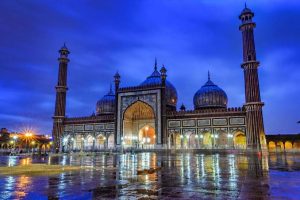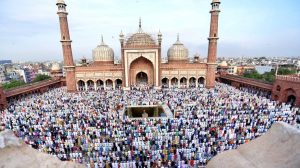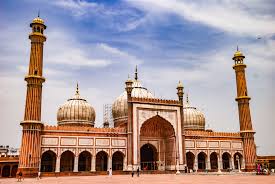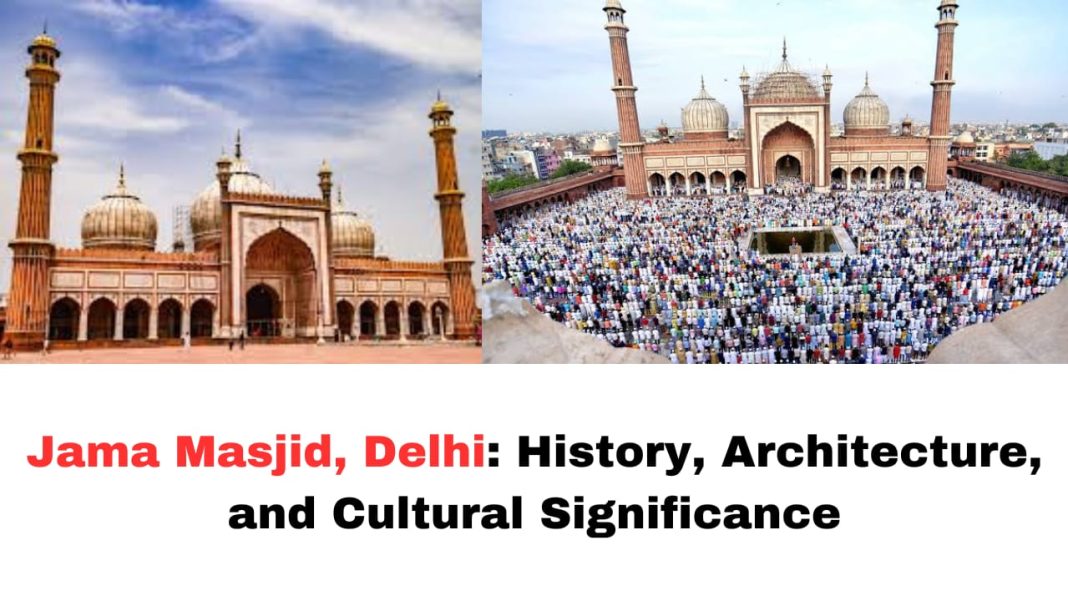Digital News Guru Delhi Desk:
Jama Masjid, Delhi: A Majestic Symbol of Mughal Architecture
Jama Masjid, one of the largest and most significant mosques in India, stands proudly in the heart of Old Delhi. It is not only a religious landmark but also an architectural masterpiece and a symbol of the Mughal era’s splendor. Built by the Mughal Emperor Shah Jahan between 1644 and 1658, the Jama Masjid is a testament to the grandeur of Mughal architecture, showcasing the empire’s artistic and cultural excellence. With its imposing structure, intricate designs, and rich history, the mosque remains a significant part of India’s heritage.
Historical Significance
The construction of Jama Masjid was commissioned by Shah Jahan, the ruler famous for his architectural feats, most notably the Taj Mahal. The mosque was built to cater to the growing Muslim population of Delhi and to serve as the central mosque for the Mughal Empire. Its location, in the bustling streets of Chandni Chowk, reflects the Mughal rulers’ intention to establish a prominent center of religious and cultural life in the capital.

The mosque was built using red sandstone and white marble, a characteristic feature of Mughal architecture. Shah Jahan’s reign saw the zenith of Mughal architecture, with the emperor heavily influenced by Persian and Central Asian styles. Jama Masjid is not just a place of worship; it was also envisioned as a symbol of the Mughal Empire’s power and religious authority. It became an iconic representation of the Mughal era, attracting pilgrims, scholars, and artists from across the empire and beyond.
Architectural Grandeur
Jama Masjid’s architecture is a stunning blend of Indo-Islamic and Persian influences. The mosque is designed in the traditional Mughal style, with large domes, grand courtyards, and intricate calligraphy. The mosque’s structure is made of red sandstone, which was sourced from nearby regions, and its white marble inlays add to its visual appeal. The central dome, which stands 40 meters high, is the most striking feature of the mosque’s design. Flanked by two smaller domes, the central dome’s grandeur is accentuated by the mosque’s elevated position, making it visible from miles around.
The mosque’s courtyard is vast and can accommodate up to 25,000 worshippers at a time. The floor is covered with intricate patterns, and at the far end of the courtyard stands the main prayer hall. The prayer hall is divided into multiple arches, and its interior is adorned with delicate floral motifs and calligraphy. The walls of the mosque also feature beautiful inscriptions from the Quran, further enhancing its spiritual and artistic appeal.
The mosque’s minarets, which rise 40 meters above the ground, are one of the most distinctive features of its design. These minarets, made of red sandstone, are decorated with intricate carvings and inscriptions. They provide a perfect vantage point, offering sweeping views of the surrounding city and the bustling markets of Chandni Chowk.

Religious and Cultural Significance
As one of the largest and most important mosques in India, Jama Masjid holds immense religious significance. It is the principal mosque for the Muslim community in Delhi and plays a vital role in the city’s religious life. Every Friday, the mosque witnesses large congregations for the Jumu’ah prayers, and during major Islamic festivals such as Eid, the mosque is packed with devotees. Jama Masjid’s role as a place of worship is complemented by its position as a cultural and intellectual center, attracting scholars, poets, and theologians from all over the world.
Jama Masjid also serves as an important symbol of Islamic identity in India. It represents the enduring influence of Mughal culture and the historical significance of the Muslim community in India. The mosque’s history is intertwined with the larger narrative of the Mughal Empire, which ruled India for over 300 years, leaving behind a legacy of art, culture, and architecture. As a place of learning and reflection, Jama Masjid continues to be a spiritual center for Muslims in Delhi and beyond.
Visitors and Tourism
Jama Masjid is one of the most visited tourist attractions in Delhi. Its historical and architectural significance draws thousands of visitors, both local and international, every year. The mosque is a popular destination for those interested in Indian history, architecture, and culture. The bustling streets of Chandni Chowk, with their vibrant markets, add to the experience of visiting the mosque. Tourists can also visit the nearby Red Fort, another iconic Mughal structure, which further enhances the historical appeal of the area.
Visitors to the mosque are welcomed to explore the mosque’s architectural beauty and serenity, though there are a few rules and regulations. Modest dress is required, and shoes must be removed before entering the mosque. Despite the large crowds, the mosque retains an air of tranquility, providing a peaceful space for reflection and prayer. The site also offers a unique blend of the past and present, where ancient traditions coexist with the modernity of the surrounding city.
Preservation and Challenges
Over the centuries, Jama Masjid has faced several challenges in maintaining its grandeur. Despite undergoing restoration and conservation efforts, the mosque has been subjected to the ravages of time and weather. The delicate marble inlays, intricate carvings, and calligraphy require constant upkeep to preserve their beauty. Additionally, the mosque is located in a densely populated area, and the traffic congestion and pollution in the vicinity pose further challenges to its preservation.

The government of India, along with various cultural organizations, has undertaken initiatives to preserve the mosque’s architectural and cultural heritage. These efforts include regular maintenance, cleaning, and conservation projects to protect the structure from further decay. The mosque remains a symbol of India’s rich cultural heritage, and ensuring its preservation is a priority for both the government and the local community.
Conclusion
Jama Masjid is more than just a mosque; it is a testament to the grandeur and architectural brilliance of the Mughal era. From its historical significance to its awe-inspiring architecture, the mosque continues to captivate the imagination of all who visit. It stands as a symbol of India’s rich and diverse cultural and religious heritage, reminding us of a bygone era while continuing to serve as a living, breathing space for prayer and reflection. As one of the most important landmarks in Delhi, Jama Masjid remains an iconic representation of India’s Islamic history and cultural legacy.
You May Also Read: Varun Dhawan Comments on Anushka Sharma’s Influence on Virat Kohli’s Life








